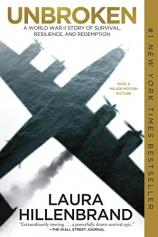Unbroken: A World War II Story of Survival, Resilience, and Redemption
Review
Unbroken: A World War II Story of Survival, Resilience, and Redemption
Laura Hillenbrand admits that after she completed her remarkable biography of a racehorse, SEABISCUIT: An American Legend, she had little hope that she would ever find another subject as compelling to write about. But “When I had my first conversation with the infectiously effervescent and apparently immortal Louie Zamperini, I changed my mind.”
A bad kid from a good working class family, Zamperini was defiant as a boy, all the way up to high school. The police knew who he was, and his father had just about given up on reforming him when he remarkably decided to reform himself after seeing that some “bad kids” were ending up in institutions for the feeble-minded and criminally incorrigible. He worked on his schooling and started to run. He ran so well, so effortlessly, that in the fateful year of 1936 he went to the Olympics. His run there was distinguished not by winning (he came in 8th), but by the fact that he came from way behind, making up 50 yards in one lap and pulling the fastest time for any runner that year. He became a worldwide celebrity and was on target to take the gold in the 1940 Games. But those Games never happened. The world was at war, and Zamperini joined the military.
Despite a fear of flying, he found himself in the Air Force. Not long after arriving in the Pacific, Zamperini was on a mission to find a plane that had gone down, when the plane he was in fell into the sea. By amazing feats of will, he managed not only to pull himself up from the bottom of the ocean, but also to save two companions by dragging them onto two small life rafts. The rafts were pitifully equipped, and one of the three men started their harrowing adventure by eating nearly all of the chocolate, a move that later made him so disconsolate and guilty that he died on the voyage. They got by under unbelievable hardships, collecting rainwater, teaching each other things they had learned in school, and reciting old family recipes to keep their mental faculties from fading. They finally learned how to catch and eat the sharks that constantly surrounded them, and even survived a strafing from the Japanese that tore one of the rafts to shreds.
But that 46-day stint in the raft was only the beginning of Zamperini’s horrors, as it ended in capture by the Japanese and a long stay at a POW camp run by a sadistic soldier known to the other prisoners as the Bird. The Bird immediately dubbed Zamperini “prisoner number one,” singling him out for nearly daily beatings with fists, feet, and once, a belt with a heavy buckle. Other Japanese camp personnel included a doctor dubbed the Quack, who enforced the Bird’s policies with medical “treatments” that included injecting prisoners with a liquid torture potion. Men died from systematic pummeling of their bodies, diseases such as beriberi, and slow starvation. Their spirits were tried by cruel humiliations. A few guards were able to give surreptitious compassionate care to the prisoners, but under orders many of them were also forced to mete out beatings. Amazingly, the prisoners “fought back” in small, morale-building ways, ingeniously stealing small amounts of rice or destroying the Japanese equipment they were charged with loading onto ships bound for war.
After the war, the Bird preposterously declared that at the time he was in command, he had never heard of the Geneva Convention. He lived in hiding for years until he was given amnesty along with others on a “most wanted” list of war criminals. The statistics tell the story --- only one percent of Allied POWs died while in captivity in Germany, while in Japan the percentage was near 40, and that does not count the thousands whose names were never recorded. Zamperini had been singled out for a reason: knowing his worldwide name recognition, the Japanese hoped to break his spirit and force him to record propaganda against the US. Once Zamperini realized what they were up to, he refused, marking himself for further maltreatment and, if the Japanese lost the war, almost certain death.
But Zamperini survived and eventually returned to his family. How he came back from the brink of self-destruction after the war and re-emerged as an unbroken man is a story in itself. When he went to Japan for the 1998 Olympics to carry the torch, running past the buried ruins of one of the camps where he suffered torture and terror at the hands of the Bird, the Quack and other sadistic masters, he was a free man who had miraculously learned to forgive.
UNBROKEN is a riveting read; once you pick it up, be prepared for a long weekend living inside the mind of Louis Zamperini and his companions, including many of the Japanese captors. Taken from extensive personal interviews, diaries, letters and archives, and aided by the fact that Zamperini, now in his 90s, is a “superlative pack rat,” Hillenbrand has constructed a detailed, dramatic saga to help all of us remember and respect the men and women who serve so valiantly. In the case of Zamperini, that respect reaches the realms of awe.
Reviewed by Barbara Bamberger Scott on November 16, 2010
Unbroken: A World War II Story of Survival, Resilience, and Redemption
- Publication Date: November 4, 2014
- Genres: Biography, History, Nonfiction
- Paperback: 528 pages
- Publisher: Random House Trade Paperbacks
- ISBN-10: 081298711X
- ISBN-13: 9780812987119





